储能科学与技术 ›› 2025, Vol. 14 ›› Issue (1): 240-254.doi: 10.19799/j.cnki.2095-4239.2024.0710
关苏敏1,4( ), 钟声远2, 李翰宸3, 丁若晨2, 苏文3(
), 钟声远2, 李翰宸3, 丁若晨2, 苏文3( ), 蔺新星2, 汤正阳1,4, 杜娟1
), 蔺新星2, 汤正阳1,4, 杜娟1
收稿日期:2024-07-31
修回日期:2024-08-14
出版日期:2025-01-28
发布日期:2025-02-25
通讯作者:
苏文
E-mail:guan_sumin@ctg.com.cn;suwenzn@csu.edu.cn
作者简介:关苏敏(1984—),女,本科,研究方向为氢能及新能源,E-mail:guan_sumin@ctg.com.cn;
基金资助:
Sumin GUAN1,4( ), Shengyuan ZHONG2, Hanchen LI3, Ruochen DING2, Wen SU3(
), Shengyuan ZHONG2, Hanchen LI3, Ruochen DING2, Wen SU3( ), Xinxing LIN2, Zhengyang TANG1,4, Juan DU1
), Xinxing LIN2, Zhengyang TANG1,4, Juan DU1
Received:2024-07-31
Revised:2024-08-14
Online:2025-01-28
Published:2025-02-25
Contact:
Wen SU
E-mail:guan_sumin@ctg.com.cn;suwenzn@csu.edu.cn
摘要:
作为一种新型的压缩储能技术,压缩CO2储能近年来受到学术界及企业界的广泛关注,可满足我国大规模长时储能的需求,具有良好的发展前景。对此,本文从压缩CO2储能系统、CO2存储装置两方面梳理了该技术的研究现状。结果表明,现有压缩CO2储能系统主要分为5类,即低压罐超临界/高压罐超临界储能、低压罐液态/高压罐超临界储能、低压罐气态/高压罐超临界储能、低压罐液态/高压罐液态储能、低压罐气态/高压罐液态储能。理论研究主要在于系统性能的稳态分析,鲜有系统全工况的动态特性分析,而示范项目则多采用高压液态-低压常压柔性存储的储能方案。对于CO2存储装置,主要有地下咸水层、地下盐穴、柔性储气棚、吸附储气床、储气罐及储液罐,其中柔性储气棚、储气/液罐已有工程应用,但储气棚体积巨大,而储罐内CO2在充放电过程中的热力特性仍需进一步研究。在此基础上,本文介绍了压缩CO2储能系统未来发展的趋势。一方面,压缩CO2储能涉及多种能源形式,可与外界冷热源及其他热力系统耦合,以满足负荷侧冷热电储的需求,提高系统整体能效水平。另一方面,可引入有机工质与CO2混合,解决低压CO2液态存储的易结干冰、系统压比较低的问题,从而实现高低压液态存储,以极大提高压缩储能密度。
中图分类号:
关苏敏, 钟声远, 李翰宸, 丁若晨, 苏文, 蔺新星, 汤正阳, 杜娟. 压缩CO2 储能技术研究现状及发展趋势[J]. 储能科学与技术, 2025, 14(1): 240-254.
Sumin GUAN, Shengyuan ZHONG, Hanchen LI, Ruochen DING, Wen SU, Xinxing LIN, Zhengyang TANG, Juan DU. Research status and development trend of compressed CO2 energy storage technology[J]. Energy Storage Science and Technology, 2025, 14(1): 240-254.
表1
压缩CO2 储能系统分类及结构示例"
| 类型 | 系统示例 | 优缺点 |
|---|---|---|
| 低压罐超临界/高压罐超临界S-CO2/ S-CO2 |  | 优点: √变容积等压储罐下储能密度大[ 缺点: √高低压储罐压力较高,且系统压比较低; √等容储罐下CO2密度随压力变化较低,储罐体积大,储能密度小且有滑压损失 |
低压罐液态/高压罐超临界 L-CO2/ S-CO2 | 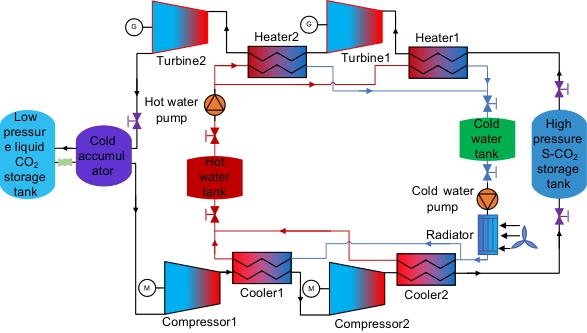 | 优点: √CO2液态储罐压力及温度均在临界点以下; √等容液态储罐下CO2呈气液两相,储能密度大[ 缺点: √等容高压罐下,CO2充放前后密度差较小,储罐体积大且有滑压损失 |
低压罐气态/高压罐超临界 V-CO2/ S-CO2 | 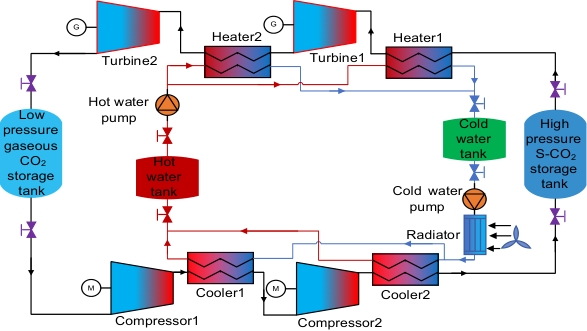 | 优点: √低压气态储罐压力低于临界压力,系统压力较大,CO2做功能力强[ √变容积等压储罐下储能密度大。 缺点: √等容储罐下储能密度小且有滑压损失 |
低压罐液态/高压罐液态 L-CO2/ L-CO2 | 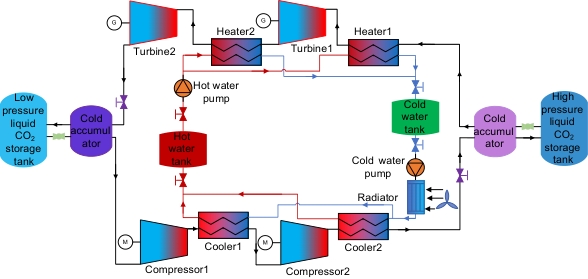 | 优点: √等容液态储罐下CO2呈气液两相,可极大提高储能密度[ 缺点: √高低压侧液态储罐压力与温度相关,为保证系统压比,低压罐温度低,可能导致结干冰 |
低压罐气态/高压罐液态 V-CO2/ L-CO2 | 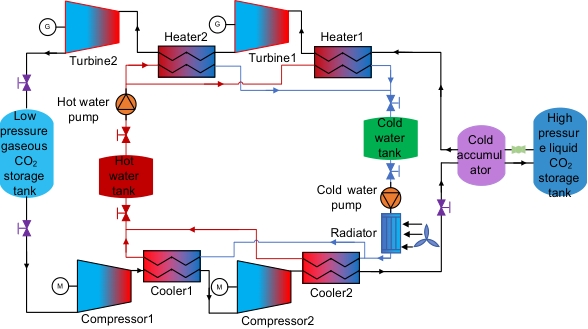 | 优点: √系统压比高,且运行在临界压力以下; √等容高压液态储罐下CO2呈气液两相,储能密度高。 缺点: √低压气态下CO2密度低,所需储气罐体积大[ |
表2
CO2 存储方式及特点"
| 存储CO2方式 | 装置示例 | 优缺点 |
|---|---|---|
| 地下咸水层 | 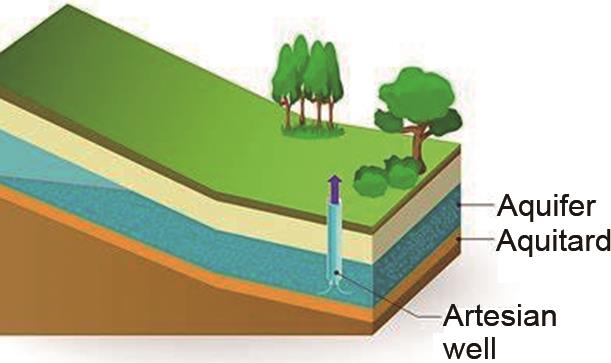 | 优点: √压力相对稳定,运行成本低。 缺点: √依赖特殊地理条件,漏气不易监测,岩石层地质环境复杂,运行安全稳定性难以保障[ √CO2可溶于水,有效储气占比低[ |
| 地下盐穴 | 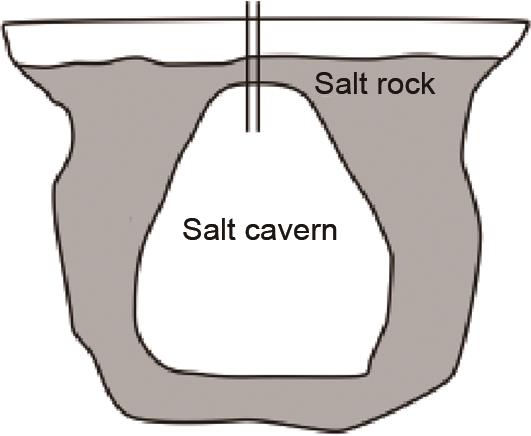 | 优点: √投资成本及运行成本低。 缺点: √体积固定,存在压力及温度波动,不利于旋转机械的稳定运行[ √为防止盐穴垮塌,存储压力较高 |
| 柔性储气棚 |  | 优点: √压力相对稳定,可变容积,常压柔性材料成本低[ 缺点: √储能密度小,占用空间大,受限于材料一般用于低压端储气[ |
| 吸附储气床 |  | 优点: √压力相对稳定,体积小,储能密度高[ 缺点: √吸附和解析的速度难以满足储释能发电需求; √一般用于低压端储气,装置及流程复杂,性能影响因素多[ |
| 储气罐 |  | 优点: √存储压力高,布置灵活。 缺点: √储能密度小,体积大,成本高; √储气压力及温度在较大范围内往复变化,存在疲劳失效的风险 |
| 储液罐 | 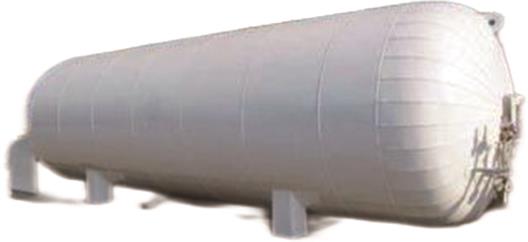 | 优点: √存储压力高,布置灵活; √气液两相存储,储能密度大,压力和温度往复变化的幅度较小[ 缺点: √为防止干冰的出现,实际工程压力应在1 MPa以上,导致低压侧压力较大 |
| 1 | 陈海生, 李泓, 徐玉杰, 等. 2023年中国储能技术研究进展[J]. 储能科学与技术, 2024, 13(5): 1359-1397. DOI: 10.19799/j.cnki.2095-4239.2024.0441. |
| CHEN H S, LI H, XU Y J, et al. Research progress on energy storage technologies of China in 2023[J]. Energy Storage Science and Technology, 2024, 13(5): 1359-1397. DOI: 10.19799/j.cnki.2095-4239.2024.0441. | |
| 2 | 聂子攀, 肖立业, 邱清泉, 等. 地下抽水蓄能发展综述[J]. 储能科学与技术, 2024, 13(5): 1606-1619. DOI: 10.19799/j.cnki.2095-4239.2023.0934. |
| NIE Z P, XIAO L Y, QIU Q Q, et al. Overview of the development of underground pumped hydro storage[J]. Energy Storage Science and Technology, 2024, 13(5): 1606-1619. DOI: 10.19799/j.cnki.2095-4239.2023.0934. | |
| 3 | 郭丁彰,尹钊,周学志,等. 压缩空气储能系统储气装置研究现状与发展趋势 [J]. 储能科学与技术, 2021, 10 (05): 1486-1493. |
| GUO D Z, YI D, ZHOU X Z, et al. Research status and development trend of gas storage device of compressed air energy storage system [J]. Energy storage science and technology, 2021, 10 (05): 1486-1493. | |
| 4 | 孙健, 陶建龙, 胡芸蓉, 等. 基于热泵型储电技术国内外研究综述[J]. 储能科学与技术, 2024, 13(6): 1963-1976. DOI: 10.19799/j.cnki.2095-4239.2023.0938. |
| SUN J, TAO J L, HU Y R, et al. Summary of research on power storage technology based on heat pump at home and abroad[J]. Energy Storage Science and Technology, 2024, 13(6): 1963-1976. DOI: 10.19799/j.cnki.2095-4239.2023.0938. | |
| 5 | 刘文军, 贾东强, 曾昊旻, 等. 飞轮储能系统的发展与工程应用现状[J]. 微特电机, 2021, 49(12): 52-58. DOI: 10.3969/j.issn.1004-7018.2021.12.011. |
| LIU W J, JIA D Q, ZENG H M, et al. Development and engineering application status of flywheel energy storage system[J]. Small & Special Electrical Machines, 2021, 49(12): 52-58. DOI: 10.3969/j.issn.1004-7018.2021.12.011. | |
| 6 | 孟祥飞, 庞秀岚, 崇锋, 等. 电化学储能在电网中的应用分析及展望[J]. 储能科学与技术, 2019, 8(S1): 38-42. DOI: 10.19799/j.cnki.2095-4239.2019.0196. |
| MENG X F, PANG X L, CHONG F, et al. Application analysis and prospect of electrochemical energy storage in power grid[J]. Energy Storage Science and Technology, 2019, 8(S1): 38-42. DOI: 10.19799/j.cnki.2095-4239.2019.0196. | |
| 7 | 韩丛宇, 石勇. 基于电磁储能的电网新能源消纳能力仿真分析[J]. 计算机仿真, 2021, 38(1): 51-55. DOI: 10.3969/j.issn.1006-9348.2021.01.012. |
| HAN C Y, SHI Y. Simulation analysis of new energy consumption capacity of power grid based on electromagnetic energy storage[J]. Computer Simulation, 2021, 38(1): 51-55. DOI: 10.3969/j.issn.1006-9348.2021.01.012. | |
| 8 | LIANG Y R, LI P, XING L L, et al. Current status of thermodynamic electricity storage: Principle, structure, storage device and demonstration[J]. Journal of Energy Storage, 2024, 80: 110347. DOI: 10.1016/j.est.2023.110347. |
| 9 | 万明忠, 王元媛, 李峻, 等. 压缩空气储能技术研究进展及未来展望[J]. 综合智慧能源, 2023, 45(9): 26-31. |
| WAN M Z, WANG Y Y, LI J, et al. Research progress and prospect of compressed air energy storage technology[J]. Integrated Intelligent Energy, 2023, 45(9): 26-31. | |
| 10 | LI F H, XING L L, SU W, et al. An idea to construct integrated energy systems of data center by combining CO2 heat pump and compressed CO2 energy storage[J]. Journal of Energy Storage, 2024, 75: 109581. |
| 11 | 李阳海, 梅欣, 徐万兵, 等. 采用不同工质的压缩气体储能系统热力性能对比分析[J]. 动力工程学报, 2023, 43(2): 269-274. DOI: 10.19805/j.cnki.jcspe.2023.02.019. |
| LI Y H, MEI X, XU W B, et al. Comparative analysis of thermal performance of compressed gas energy storage systems using different working fluids[J]. Journal of Chinese Society of Power Engineering, 2023, 43(2): 269-274. DOI: 10.19805/j.cnki.jcspe. 2023.02.019. | |
| 12 | 郝佳豪, 越云凯, 张家俊, 等. 二氧化碳储能技术研究现状与发展前景[J]. 储能科学与技术, 2022, 11(10): 3285-3296. DOI: 10.19799/j.cnki.2095-4239.2022.0199. |
| HAO J H, YUE Y K, ZHANG J J, et al. Research status and development prospect of carbon dioxide energy-storage technology[J]. Energy Storage Science and Technology, 2022, 11(10): 3285-3296. DOI: 10.19799/j.cnki.2095-4239.2022.0199. | |
| 13 | 郑平洋,郝佳豪,常鸿, 等. 基于不同液化方式的液态二氧化碳储能系统研究进展[J]. 南方能源建设, 2024, 11(2): 102-111. |
| ZHENG P Y, HAO J H, CHANG H, et al. Research progress of liquid carbon dioxide energy storage system based on different liquefaction methods[J]. Southern energy construction, 2024, 11(2): 102-111. | |
| 14 | ZHANG X R, WANG G B. Thermodynamic analysis of a novel energy storage system based on compressed CO2 fluid[J]. International Journal of Energy Research, 2017, 41(10): 1487-1503. DOI: 10.1002/er.3732. |
| 15 | TANG B, SUN L, XIE Y H. Comprehensive performance evaluation and optimization of a liquid carbon dioxide energy storage system with heat source[J]. Applied Thermal Engineering, 2022, 215: 118957. DOI: 10.1016/j.applthermaleng. 2022.118957. |
| 16 | 郝银萍. 跨临界压缩二氧化碳储能系统热力学特性及技术经济性研究[D]. 北京: 华北电力大学, 2021. DOI: 10.27140/d.cnki.ghbbu.2021.000057. |
| HAO Y P. Study on thermodynamic characteristics and technical economy of transcritical compressed carbon dioxide energy storage system[D]. Beijing: North China Electric Power University, 2021. DOI: 10.27140/d.cnki.ghbbu.2021.000057. | |
| 17 | LIU Z, LIU Z H, XIN X, et al. Proposal and assessment of a novel carbon dioxide energy storage system with electrical thermal storage and ejector condensing cycle: Energy and exergy analysis[J]. Applied Energy, 2020, 269: 115067. DOI: 10.1016/j.apenergy.2020.115067. |
| 18 | ZHAO R J, LIU Z. Thermo-economic performance of a compressed CO2 energy storage system with a flexible gas holder[J]. Journal of Energy Storage, 2023, 60: 106675. DOI: 10.1016/j.est.2023.106675. |
| 19 | ZHANG T H, ZHANG S Q, GAO J M, et al. Feasibility assessment of a novel compressed carbon dioxide energy storage system based on 13X zeolite temperature swing adsorption: Thermodynamic and economic analysis[J]. Applied Energy, 2023, 348: 121562. DOI: 10.1016/j.apenergy. 2023.121562. |
| 20 | ZHANG T H, QIN S S, WEI G H, et al. Thermodynamic analysis of a novel trans-critical compressed carbon dioxide energy storage system based on 13X zeolite temperature swing adsorption[J]. Energy, 2023, 282: 128399. DOI: 10.1016/j.energy. 2023.128399. |
| 21 | ZHANG T H, GAO J M, ZHANG Y, et al. Thermodynamic analysis of a novel adsorption-type trans-critical compressed carbon dioxide energy storage system[J]. Energy Conversion and Management, 2022, 270: 116268. DOI: 10.1016/j.enconman. 2022.116268. |
| 22 | DENG Y Y, WANG J F, CAO Y, et al. Technical and economic evaluation of a novel liquid CO2 energy storage-based combined cooling, heating, and power system characterized by direct refrigeration with phase change[J]. Applied Thermal Engineering, 2023, 230: 120833. DOI: 10.1016/j.applthermaleng.2023.120833. |
| 23 | YAN X W, DING J L, ZHANG Y L, et al. Thermodynamic evaluation on a new CO2 energy storage system assisted by adsorption bed[J]. Journal of Energy Storage, 2023, 61: 106775. DOI: 10.1016/j.est.2023.106775. |
| 24 | LIU Z, YAN X W, WANG S, et al. Performance of compressed CO2 energy storage systems with different liquefaction and storage scenarios[J]. Fuel, 2024, 359: 130527. DOI: 10.1016/j.fuel.2023.130527. |
| 25 | 中国东方电气集团有限公司. 全球首个二氧化碳+飞轮储能示范项目在东方电气竣工 [EB/OL] [2022-09-05]. http://www.sasac.gov.cn/n2588025/n2588124/c25926182/content.html. |
| China Dongfang Electric Group Co., Ltd. The world's first CO2 + flywheel energy storage demonstration project has been completed at Dongfang Electric. [EB/OL] [2022-09-05]. http://www.sasac.gov.cn/n2588025/n2588124/c25926182/ content.html. | |
| 26 | 叶宇虹. 芜湖海螺建成全球首套二氧化碳储能商业示范系统 [EB/OL].[2024-01-19]. http://www.fcxnews.cn/fcyw/202401 /t20240118_7327036.html. |
| YE H Y. Wuhu Conch has completed the world's first commercial demonstration system for carbon dioxide energy storage. [EB/OL].[2024-01-19]. http://www.fcxnews.cn/fcyw/202401/t20240118_7327036.html. | |
| 27 | 吕雅宁.博睿鼎能完成数千万元天使轮融资,聚焦液态二氧化碳储能技术 [EB/OL].[2023-10-25]. https://baijiahao.baidu.com/s?id=1780720794800066549&wfr=spider&for=pc |
| LV Y N. Borui Dingneng has completed tens of millions of yuan in angel round financing, focusing on liquid carbon dioxide energy storage technology. [EB/OL].[2023-10-25]. https://baijiahao.baidu.com/s?id=1780720794800066549&wfr=spider&for=pc | |
| 28 | ENERGYDOME. CO2-battery, [EB/OL]. [2023-10-25]. https://energydome.com. |
| 29 | 喻浩. 深部含水层压缩二氧化碳储能系统的数值模拟研究[D]. 长沙: 长沙理工大学, 2019. DOI: 10.26985/d.cnki.gcsjc.2019.001079. |
| YU H. Numerical simulation of compressed carbon dioxide energy storage system in deep aquifer[D]. Changsha: Changsha University of Science & Technology, 2019. DOI: 10.26985/d.cnki.gcsjc.2019.001079. | |
| 30 | LIU H, HE Q, BORGIA A, et al. Thermodynamic analysis of a compressed carbon dioxide energy storage system using two saline aquifers at different depths as storage reservoirs[J]. Energy Conversion and Management, 2016, 127: 149-159. DOI: 10.1016/j.enconman.2016.08.096. |
| 31 | ZHANG Y, LI W J, CHEN G D. A thermodynamic model for carbon dioxide storage in underground salt Caverns[J]. Energies, 2022, 15(12): 4299. DOI: 10.3390/en15124299. |
| 32 | LIU W, DUAN X Y, LI Q H, et al. Analysis of pressure interval/injection and production frequency on stability of large-scale supercritical CO2 storage in salt Caverns[J]. Journal of Cleaner Production, 2023, 433: 139731. DOI: 10.1016/j.jclepro.2023.139731. |
| 33 | PENG Y R, GAO J M, ZHANG Y, et al. Experimental study of adsorption CO2 storage device for compressed CO2 energy storage system[J]. Journal of Energy Storage, 2023, 58: 106286. DOI: 10.1016/j.est.2022.106286. |
| 34 | LUO X, WANG J H, KRUPKE C, et al. Modelling study, efficiency analysis and optimisation of large-scale adiabatic compressed air energy storage systems with low-temperature thermal storage[J]. Applied Energy, 2016, 162: 589-600. DOI: 10.1016/j.apenergy.2015.10.091. |
| 35 | HARTMANN N, VÖHRINGER O, KRUCK C, et al. Simulation and analysis of different adiabatic Compressed Air Energy Storage plant configurations[J]. Applied Energy, 2012, 93: 541-548. DOI: 10.1016/j.apenergy.2011.12.007. |
| 36 | PHUOC T X, MASSOUDI M. Pumping gaseous CO2 into a high-pressure, constant-volume storage cylinder: A thermodynamics analysis[J]. Journal of Energy Storage, 2021, 40: 102706. DOI: 10.1016/j.est.2021.102706. |
| 37 | ZHANG Y, LIN Y H, LIN F Z, et al. Thermodynamic analysis of a novel combined cooling, heating, and power system consisting of wind energy and transcritical compressed CO2 energy storage[J]. Energy Conversion and Management, 2022, 260: 115609. DOI: 10.1016/j.enconman.2022.115609. |
| 38 | ZHANG Y, LIN F Z, LIU Z Y, et al. Energy and exergy performance evaluation of a novel low-temperature physical energy storage system consisting of compressed CO2 energy storage and Kalina cycle[J]. Journal of Energy Storage, 2023, 60: 106605. DOI: 10.1016/j.est.2023.106605. |
| 39 | FU H L, SHI J, YUAN J Q, et al. Thermodynamic analysis of photothermal-assisted liquid compressed CO2 energy storage system hybrid with closed-cycle drying[J]. Journal of Energy Storage, 2023, 66: 107415. DOI: 10.1016/j.est.2023.107415. |
| 40 | FU X T, YAN X W, LIU Z. Coupling thermodynamics and economics of liquid CO2 energy storage system with refrigerant additives[J]. Energy, 2023, 284: 128642. DOI: 10.1016/j.energy. 2023.128642. |
| 41 | TANG B, SUN L, XIE Y H. Design and performance evaluation of an energy storage system using CO2-based binary mixtures for thermal power plant under dry conditions[J]. Energy Conversion and Management, 2022, 268: 116043. DOI: 10.1016/j.enconman. 2022.116043. |
| [1] | 冯军胜, 严亚茹, 王璐, 赵亮, 董辉. 耦合低温余热回收的热泵储电系统热力学性能研究[J]. 储能科学与技术, 2024, 13(12): 4384-4395. |
| [2] | 冯军胜, 严亚茹, 赵亮, 董辉. 基于有机朗肯循环的卡诺电池热储能系统性能分析[J]. 储能科学与技术, 2024, 13(11): 3930-3938. |
| [3] | 冯军胜, 严亚茹, 王璐, 赵亮, 董辉. 耦合低温余热的HP-ORC热泵储电系统热经济性能研究[J]. 储能科学与技术, 2024, (): 1-11. |
| 阅读次数 | ||||||
|
全文 |
|
|||||
|
摘要 |
|
|||||
